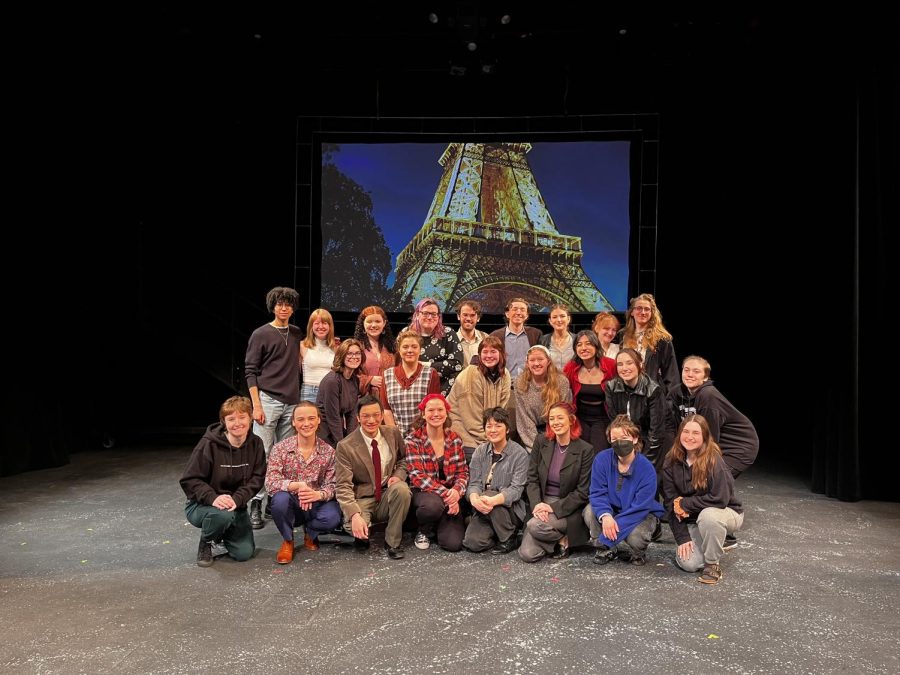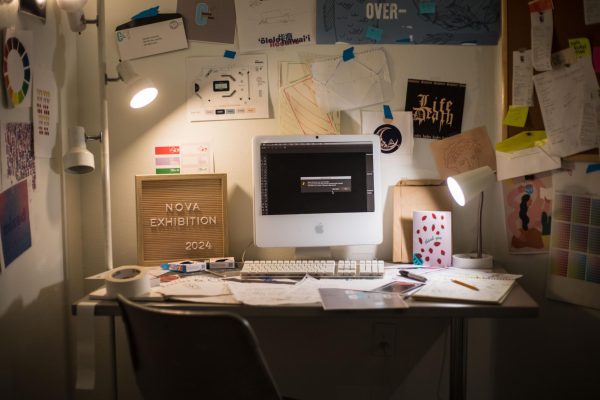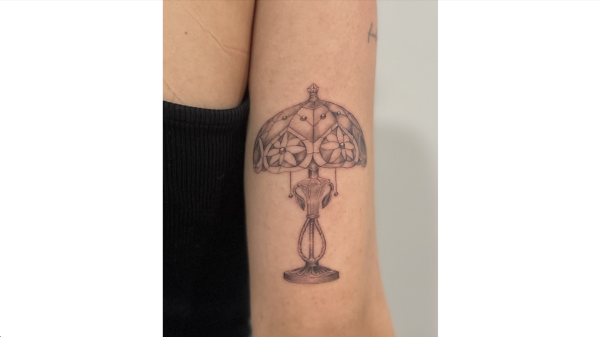French Scenes and Other Short Plays: The Beauty of Student-Led Production
Over the course of eight weeks, six short scenes transformed from idea to reality. Six students in the 4200 level directing course in the theater department created a workshop production of six short productions encompassed in “French Scenes and Other Short Plays.” Each student, with the help of mentors and peers, curated the performances, sets, lighting, sounds and presentation from start to finish. “French Scenes and Other Short Plays” had a five-show-run, starting Feb. 22 and ending with a Feb. 26 matinee.
At the beginning of the quarter, each student was asked to find a 10-minute play that intrigued them and embark on the pursuit of actualizing the scene from script to showtime. Alex Bailey, a fourth-year criminal justice and theater double major and director of “Choices” by James McLindon, painted a picture of the beginning stages of the show’s production.
“We all had the task of choosing our own short play or scene, and we’ve been working in class, with our professor teaching us as we go along. It was a very fast process,” Bailey said. “All the directors split up and came up with our own schedules on how rehearsal was going to work.”
For students like Lia Gonia, fourth-year communication and media and theater double major, this class served as their first foray into directing. As the director of “Edna and Joe” from “Waiting for Lefty” by Clifford Odets, she described her experience stepping away from her traditional role as an actor and taking on the responsibility of directing.
“Even though I was really nervous at first, it taught me a lot about being an actor as well. I kind of have a new view on auditions and rehearsals and notes that directors give,” Gonia said.
Laura Nicely, a third-year sociology and theater double major and director of “The DMV One” by Nick Zagone, echoed Gonia’s sentiment that directing offers a new perspective on what directors experience throughout the creative process of curating a scene.
“I have never actually done directing before. It has been a little weird, and it has definitely been a challenge,” Nicely said. “I realized through the process that directors don’t always have all of the answers.”
Bailey, alongside his peer directors, developed a nuanced sympathy for directors, as working in his new role presented him with challenges and decisions he hadn’t considered as an actor.
“Now, I understand the things that directors go through, and I have an understanding of why they did the things that I got annoyed with when I was an actor,” Bailey said.
With the uncertainty that inexperience brought the student directors, the advent of taking on a leadership role amongst their peers added additional pressure to the task of creating the show.
Lauren Andrade, a third-year interdisciplinary arts leadership major and director of “No Such Thing” by Douglas Hill, reflected on the experience of directing their peers, and their initial discomfort with a managerial role.
“At first it was really strange. I didn’t want to step on anyone’s toes. I didn’t want to make anyone feel bad,” Andrade said. “But we all respected each other, which is helpful, and there was always a clear line of communication making sure everyone was comfortable.”
Bailey explained that his own discomfort with taking on a directing role originated from his relationships with his peers. He had an existing friendship with one of his actors, while having never met the other.
“It was kind of weird,” Bailey said. “Having to balance that dynamic of having someone that I’m already comfortable with, with another who is younger than me and may not have as much experience…was an awkward thing to balance.”
Fin Donovan, a first-year English major and actor in both “No Such Thing” and “Rex,” discussed the advantages of working with student directors.
“It’s much more collaborative,” Donovan said. “I was messing around with some of the lines in ‘No Such Thing,’ and I said, ‘I think for the blocking we should switch one of these lines around. Can I just say this differently?’ and [the director] was like ‘Sure.’ I feel strongly that I would have gotten more pushback on that with somebody who is a little more experienced.”
Bailey reflected on how student-led productions differentiate themselves from professionally-led productions and the positive aspects he believes are gained from having student directors.
“I feel like [student directors] have so many new ideas, and perhaps, maybe they are more cut and dry in the way that they have always done things, and we bring something new to the table,” Bailey said.
Students who directed the play had the support and assistance of their mentor Brennan Murphy, an associate professor in the arts department, but the project presented specific challenges and inquiries that demanded action from the directors themselves.
Gonia described the process of working with both fourth-year and second-year actors and how she had to adapt as a leader in order to effectively collaborate with her peers. One of her actors entered the production with existing theater knowledge while the other had never been on stage before.
“I think something I really enjoyed about being in a leadership role was always offering kindness, and I feel like that’s a good way to be a leader is just to be kind and listen to people. But I think particularly what I was focusing on was reaching both of them and making sure that when I was saying my notes, my instruction was applicable to someone who has performance experience and someone who doesn’t,” Gonia said.
Directors also had to sensitively navigate complicated subject material with their peers. Nicely commented on the difficulties she encountered while guiding her actors through an intimate scene and on the efforts she put into creating a safe and professional environment for them.
“Both of my actors are teenagers, so I was like, ‘I have no idea how to handle this.’ I didn’t know where to start,” Nicely said. “I had our directing professor come in and help us figure out what to do—because he does a lot with voice—and he helped us get to a point where we figure out how to do that and not make it uncomfortable and awkward.”
After spending the quarter working diligently on their scenes, by opening night on Feb. 22, the directors were able to join the audience in watching their scenes. The culmination of weeks of growth, challenge and learning was finally left at a resolution.
“[The most rewarding part of the process] was seeing it all come together,” Bailey said. “Once I saw it on tech for our first run and I saw the actors in costume and saw everything together and they performed it, it was great. I just took a step back, and I was so happy for them, and I was like ‘Wow.’ I was so happy for everybody else because I was like ‘Look at what we did! We were all so nervous at the beginning. How did we do this?’”
Reflecting on the journey from picking a script and holding auditions to seeing the actors take their bow, Gonia notes the personal and communal aspects of the production’s commencement.
“It’s a really rewarding process, I think, to see it all come together and see my vision come to life, but also being able to collaborate with the sound designer, costume designer, lighting designer, my professor and being given ideas. It’s been a cool, collaborative, rewarding process,” Gonia said.
Donovan highlighted the people he connected with throughout the process as the best part of the production process.
“[The most rewarding part of the process was] getting to meet all the lovely people in theater. I’ve made so many friends. It’s been absolutely great,” Donovan said.
With most Seattle University theater productions led by faculty, the students involved in this performance felt that there was a unique beauty to presenting students’ work to the public.
“Especially in a college setting, showcasing a student’s work is really cool and really important,” Andrade said. “And for all the people that want to go into directing or theater, being like ‘I can do this and now I have this real, physical tangible thing that shows what I was able to accomplish’ [is affirming].”
With a 75-minute run time, “French Scenes and Other Short Plays” was a short demonstration of a larger body of student work—a quarter dedicated to choosing, curating, tweaking, perfecting and interpreting a scene to be performed for an audience.
As the production’s run closed Feb. 26, Andrade was left with a sense of relief and pride, not only at their accomplishment, but at the collective work, talent and enthusiasm displayed by all those involved in the production.
“I think that breath of ‘My God, we all did it, and we all did a really good job at it is really cool,” Andrade said.
In the case of six students, “French Scenes and Other Short Plays”was more than just a class assignment: it meant the chance to step inside the world of directing and create something they could be proud of.











